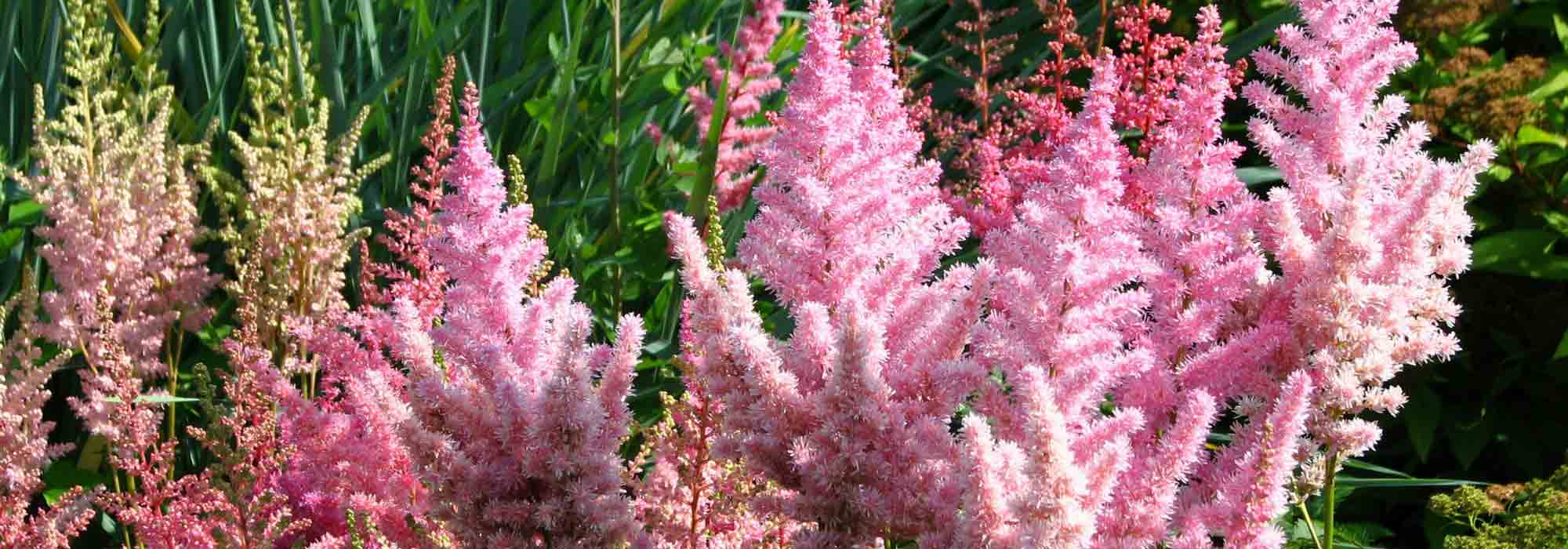
Astilbe: planting, cultivation, maintenance
Contents
Astilbe in a nutshell
- Astilbe is a perennial ideal for brightening a shady corner and the edges of water features
- Its feathery flowering in long variegated plumes blooms in early summer
- Its vigorous foliage remains spectacular until autumn
- Hardy and easy to grow in rich soil, it requires consistently moist soil
- It is emblematic of naturalistic gardens
A word from our expert
Astilbe is a herbaceous perennial plant that is well-branched, notable for the poetry of its ethereal flowering and its delicate, finely cut foliage. Unjustly overlooked, it was widely used in the past to adorn our grandmothers’ gardens, and the graceful Astilbe has made a comeback in gardens in recent years, thanks to the emergence of new varieties.
From June to August, its airy inflorescences in long plumes of pink, white, or red, which can reach over 1.5 m in height for some Astilbes, illuminate the shaded corners of the garden.
From Astilbe japonica, or Japanese Astilbe, which flowers early, to Astilbe x arendsii, a hybrid available in numerous varieties, and Astilbe chinensis, which flowers late in July-August and tolerates drier soils better than other species, all are remarkably floriferous, even in shade.
It is no coincidence that Astilbe can be found in the wild, in wooded edges near watercourses!
A perennial that loves damp places, it thrives in cool, heavy, marshy soils but also accepts any good garden soil as long as it is not too dry in summer. Astilbe is hardy (-20°C), never sick, and lives for many years in shade or partial shade.
With its varied colours and low maintenance, it enhances naturalistic gardens, the edges of water features, the garden’s wet areas, shady borders creating an evanescent mist under deciduous trees, or even rockeries and large fresh pots.
When cut, Astilbe inflorescences make very pretty fresh or dried bouquets with a rustic charm.
Romantic or fiery, ethereal, from pink Astilbe to red Astilbe, discover this beautiful, easy-to-grow perennial, essential for the banks of a pond and in cool soils!
Description and Botany
Botanical data
- Latin name Astilbe
- Family Saxifragaceae
- Common name Astilbe
- Flowering from June to August
- Height 0.20 to 1.70 m
- Exposure sun, partial shade
- Soil type Heather (Acidic), Neutral
- Hardiness -20° C
Astilbe is a rhizomatous perennial belonging to the saxifrage family, like heucheras and bergenias. The genus Astilbe includes about a dozen species native to wet environments, woods, and riverbanks, from the mountains of Southeast Asia and North America.
It is not uncommon to find wild astilbes along ditches or near wet areas.
Most astilbes grown in our gardens are horticultural hybrids created by cross-breeding different species; Astilbe x arendsii, A. davidii, A. chinensis, A. japonica, A. thunbergii, A. simplicifolia. Usually classified according to these groups, they can vary significantly in size, shape, colour, and flowering period.
Depending on the species, the height of the plants ranges from 20 cm to 1.70 m when in flower. This perennial spreads easily thanks to its rhizomes that develop at the surface. In spring, Astilbe displays a soft habit with upright tufted and bushy growth, more or less airy or dense.
A bit slow to establish, Astilbe takes two to five years to reach its full development and form a beautiful regular clump. Once well-rooted, this rhizomatous perennial grows quickly to form dense clumps.
A long-lived plant, once well established, astilbe can live for many decades.
Graceful, astilbe is particularly valued in the garden for its inflorescences in long romantic and airy plumes. From June to August, depending on the varieties, plume-like panicles that are very colourful and well-branched, measuring 20 to 50 cm long in the tallest cultivars, rise above the foliage.

From left to right: young copper foliage in spring / inflorescences ready to bloom / flowering panicles / faded inflorescences, still decorative in winter.
Lilac pink, pure white, cream white tinged with pink, pale pink, violet pink, magenta, purple, or intense red, depending on the varieties, they seem to float in the air, suspended from their delicate peduncles.
While these colourful plumes are usually upright, sometimes compact (Astilbe chinensis ‘Pumila’), they can be pendulous in some varieties (Astilbe thunbergii ‘Straussenfeder’) or slightly arched, rivaling the beard of goat (Aruncus dioicus). The flowering lasts 2 to 4 weeks. Scent is not the primary characteristic of Astilbe flowers; however, some species like Astilbe simplicifolia ‘Pink Lightning’ exude a delicate fragrance.
The airy spikes dry to shades of brown and remain very decorative throughout winter. They can be used to create large bouquets of fresh flowers (they wilt quickly) or dried ones.
The vigorous and spectacular foliage provides a backdrop for the airy inflorescences. Deciduous, the foliage disappears in winter and only reappears in spring. As it spreads, it adds a certain opulence to the plant. Of rare elegance, highly dissected, it evokes the lightness of certain ferns.
The leaves, measuring 15 to 75 cm long, are ovate to pointed, deeply lobed, divided into numerous dentate leaflets. Medium to dark green and glossy in most, they are sometimes washed with red or variegated with green and burgundy red (Astilbe ‘Colour Flash’) and can take on beautiful hues in autumn. The ‘Chocolate Shogun’ Astilbe, a new variety, develops almost black chocolate foliage.

The particularly decorative foliage of Astilbe arendsii ‘Color Flash’.
Astilbe retains beautiful foliage until the first frosts.
This beautiful perennial loves cool, shaded woodland environments that it enlivens. It is essential for wet and marshy soils.
Easy to grow, it thrives in rich, deep, always moist, and fertile soil, preferably slightly acidic, in a partially shaded position or under non-burning sun. Some hybrids are less demanding in water than other species and are better suited to ordinary soil.
It is the ideal plant to install in woodland under the cover of large deciduous trees, by a pond, and of course in borders, at the edge or in the back of a bed for the larger specimens.

Reserve the dwarf species for cool rockeries or pot cultivation.
“`
Main species and varieties
There are nearly fifteen species, including numerous hybrids and some very interesting cultivars, allowing for varied heights (Astilbes range from 20 cm to over 1.70 m in height), colours (white, pink, or red), shapes that are more or less compact, and flowering periods.
Astilbe x arendsii is a hybrid that comes in many varieties (‘Bressingham Beauty’, ‘Fanal’), while Astilbe chinensis is known for its groundcover variety ‘Pumila’. Astilbe japonica is recognised for its red varieties (‘Red Sentinel’, ‘Montgomery’), and Astilbe thunbergii ‘Straussenfeder’, meaning ostrich plume in German, is a hybrid with large trailing plume-like panicles.
The Astilbes chinensis ‘Vision’ stand out from other astilbes as they form a group of recent hybrids selected for their vigour and moderate water requirements; they thrive in ordinary soil that does not dry out.
While the hybrid astilbes X arendsii are the most common, discover with us the best astilbes selected for you, based on the quality of their flowering, rarity, or originality.
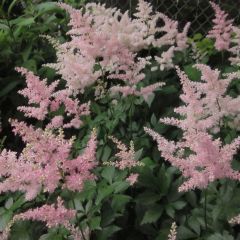
Astilbe japonica 'Peach Blossom'
- Flowering time August, September
- Height at maturity 70 cm
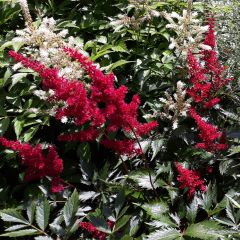
Astilbe Montgomery
- Flowering time August, September
- Height at maturity 60 cm
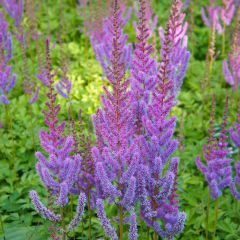
Astilbe chinensis Pumila
- Flowering time August to October
- Height at maturity 30 cm
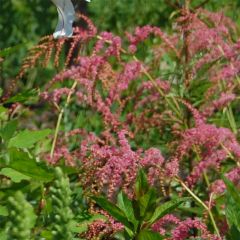
Astilbe thunbergii 'Straussenfeder'
- Flowering time August, September
- Height at maturity 1 m
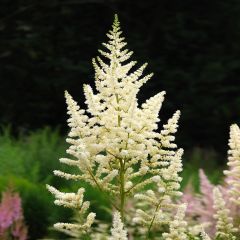
Astilbe Deutschland
- Flowering time July, August
- Height at maturity 50 cm
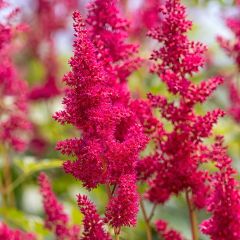
Astilbe Fanal
- Flowering time July, August
- Height at maturity 60 cm
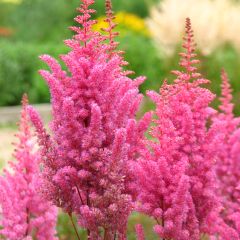
Astilbe chinensis 'Veronica Klose'
- Flowering time September, October
- Height at maturity 40 cm
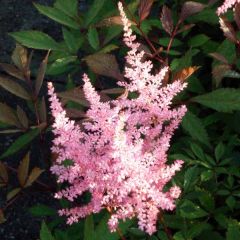
Astilbe arendsii Erika
- Flowering time August, September
- Height at maturity 80 cm
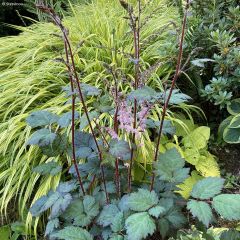
Astilbe Color Flash
- Flowering time July, August
- Height at maturity 60 cm
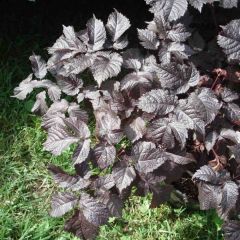
Astilbe 'Chocolate Shogun'
- Flowering time July, August
- Height at maturity 50 cm
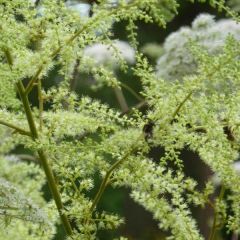
Astilbe rivularis Grandiflora - False Spirea
- Flowering time August, September
- Height at maturity 1,70 m

Astilbe chinensis Vision in Pink
- Flowering time July to September
- Height at maturity 60 cm
Discover other Astilbe - False Goatsbeard
View all →Available in 1 sizes
Available in 1 sizes
Available in 0 sizes
Available in 3 sizes
Available in 3 sizes
Available in 2 sizes
Available in 1 sizes
Available in 1 sizes
Available in 1 sizes
Available in 3 sizes
Planting
Where to Plant Astilbe?
Hardy down to -20°C, Astilbe grows almost everywhere in France, except in Mediterranean climates, which are too dry and hot in summer: its only requirement is a moist soil in summer, cool in other seasons. Conversely, Astilbe does not tolerate having its stump submerged in winter, so avoid planting it in areas that remain flooded for long weeks in winter. It will withstand summer heat in temperate regions, provided the soil remains consistently moist and cool.
Astilbe thrives in partial shade, sheltered from the scorching sun, under the foliage of deciduous trees that provide a beneficial coolness. It enjoys bright exposures but without direct sunlight during the hottest hours.
Very easy to cultivate, it does require rich organic matter and well-draining soil to bloom well. It accepts all types of soil without issue, except for calcareous, poor, dry, or stony grounds, where it will never be lush.
Its preference typically leans towards a woodland soil, neutral or acidic, which is necessary for its proper development. You can plant it in the heart of a heather bed.
It enjoys rather heavy, clayey soils kept sufficiently moist with a good mulch during the growing season. A cool soil allows it to develop vigorously.
While it fits into all decor styles, this perennial truly shines as a woodland plant, by a damp bank, or in a marshy area of the garden, where it will illuminate with its bright flowering. It will add a soft relief and striking presence in the foreground or middle of a flower bed.
When to Plant Astilbe?
Plant Astilbe in spring from February to April after the frosts or in autumn from September to October, after the heatwaves.
How to Plant Astilbes
In the Ground
Plant 3 to 5 plants per m² of different varieties, spaced at least 30 to 50 cm apart to allow the plant to develop well. For a beautiful effect in a flower bed, favour planting in small groups. It is an ideal perennial for creating a border of astilbes.
- Dig a hole 2 to 3 times wider than the root ball
- In poor soil, add some well-rotted compost at the bottom of the hole before placing the root ball
- Bring the soil back to encase the roots
- Firm the soil and then water generously until establishment and during the first year of planting
- Keep the soil cool at the base with organic mulch (hemp, for example), especially during summer; this ensures prolonged flowering
Planting Astilbe in Pots
Plant Astilbe in a large container, in a mix of potting soil and always moist compost. Spread a good layer of drainage (gravel or clay balls) at the bottom of the pot beforehand to improve drainage. Mulch and water very regularly, never allowing the substrate to dry out. Fertilize regularly with organic fertiliser during the flowering period.
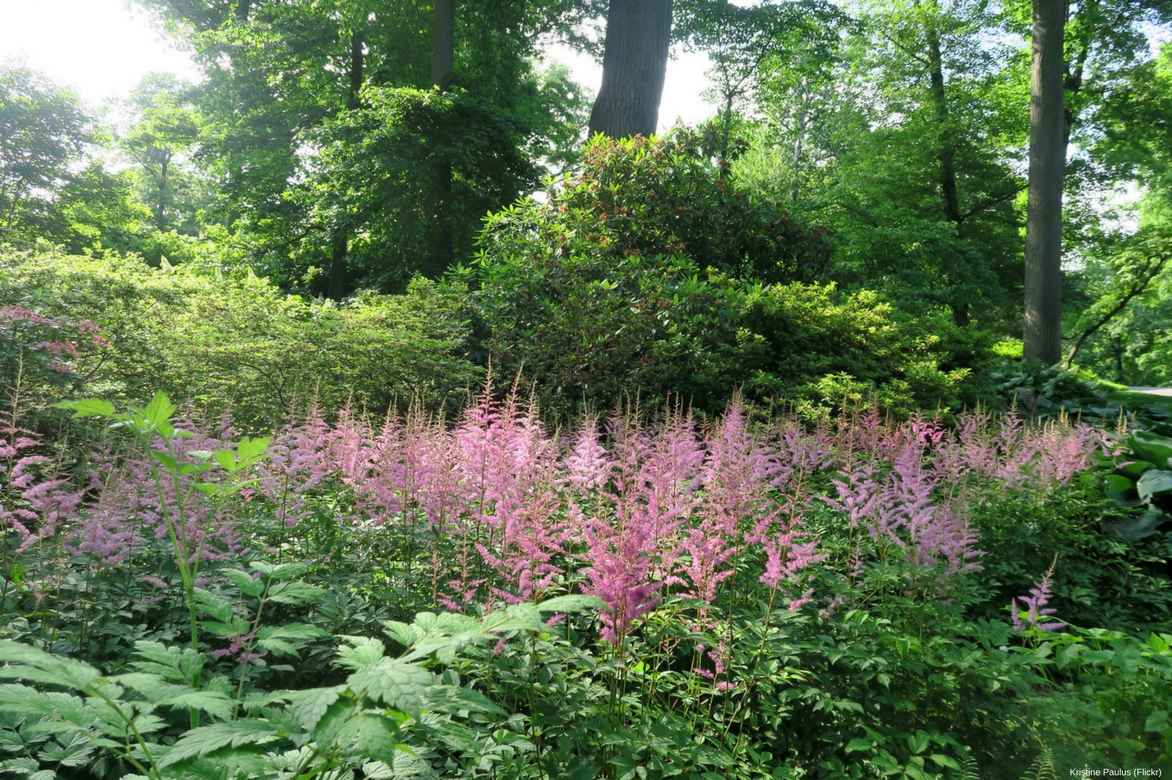
Maintenance, pruning and care
It is a hardy perennial and greedy for water. Freshness and soil moisture are the keys to success! Astilbe proves to be a lovely perennial plant without fuss, as long as the soil remains cool and sufficiently nourishing.
Chinese Astilbes tolerate dry conditions and periods of drought better than most species. For the others: the soil must be kept sufficiently moist in summer, or they will quickly wither in the event of drought.
- Install a good organic mulch around the base to limit evaporation
- Water daily during heatwaves but avoid flooding
- Astilbes are greedy: fertilise each year in March with compost (5 cm thick), to improve drainage in winter and facilitate root development
- Every 2 or 3 years, at the end of winter, spread a few handfuls of compost at the base of the plant, to cover the roots exposed by watering.
- Prune faded flowers after flowering to encourage better foliage development or leave them to dry on the stem to keep them all winter
Diseases and potential pests
Hardy, the Astilbe is a young plant that resists insects and diseases.
It is only susceptible to powdery mildew, a fungus identifiable by the white fluff it leaves on the foliage. Spray Bordeaux mixture as a preventive measure, along with nettle and horsetail manure. Do not leave any residues of diseased plants on the soil; burn them.
The flower buds may be at risk from late spring frosts.
In case of water shortage, brown spots may appear on the foliage.
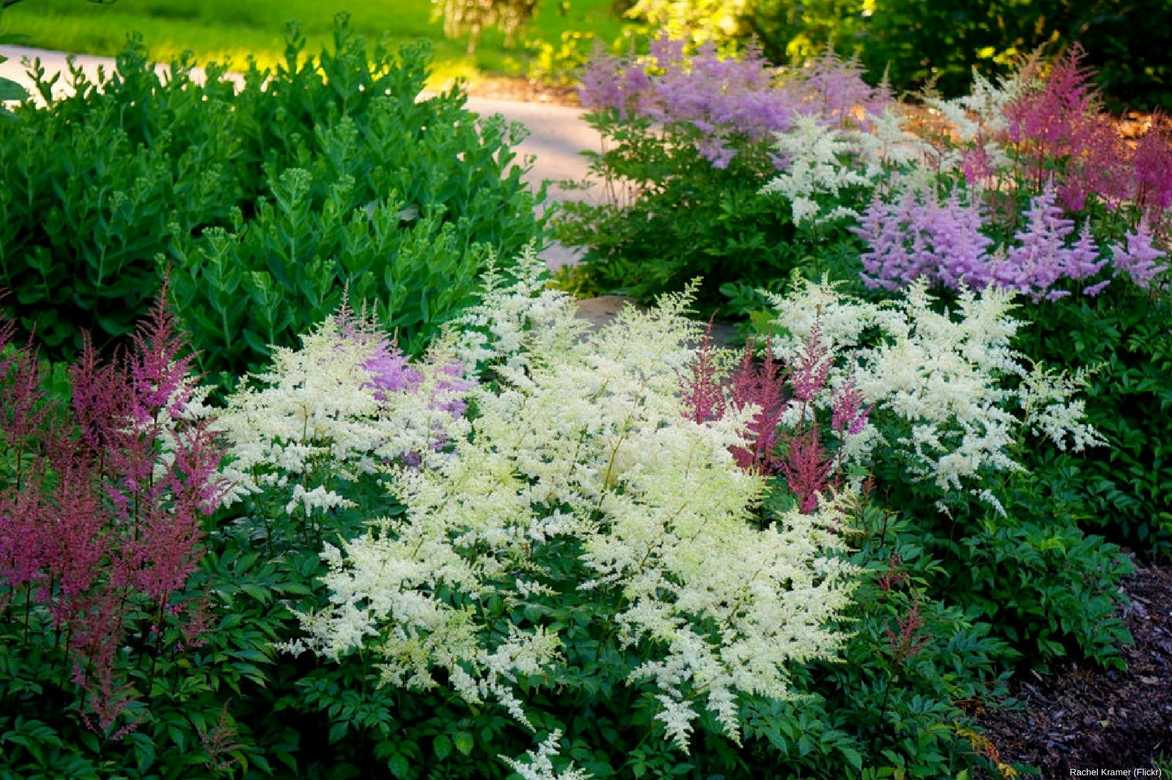
Multiplication
Astilbe can be easily multiplied by dividing clumps. After 4-5 years, when the plant is well established, from December to March, divide the largest stumps to rejuvenate the plant and maintain beautiful flowering. Ideally, divide the rootstocks every 4 years, as with age, the centre of the clump tends to weaken and become less floriferous.
- Using a forked spade, dig up part of the stump before the leaves reappear
- With a swift motion of the spade, slice off a nice chunk of the clump
- Immediately replant the chunks in the garden in well-prepared soil or pot them to be planted out the following June, once they have established well.
Associating Astilbe in the Garden
Sure value for shade gardens and marsh gardens, Astilbe is perfect for brightening cool areas and playing with shades and gradients, quickly laying the groundwork for a elegant and refined atmosphere. Following the spring blooms, it takes over before the summer profusion.
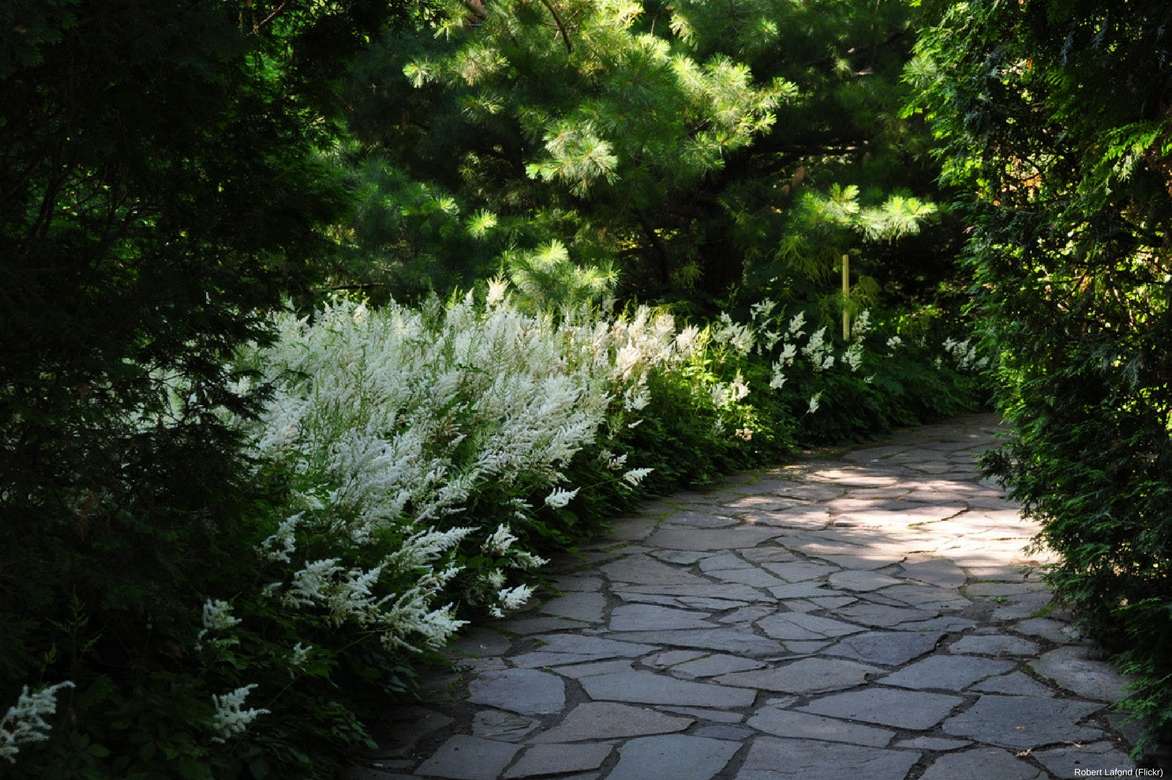
Astilbes brighten shaded paths.
With its feathery silhouette, delicate and light foliage, and pastel or fiery crimson inflorescences, it transforms a simple bed or a damp border into a poetic or vibrant tableau.
Whether over 1 m tall or ground-covering, it integrates into all shaded settings, serving as a dazzling mid-border plant creating an ethereal mist or as a flowering carpet for cool rockeries.
It adds charm to soft, countryside-style gardens or prairie styles, bringing breath, exuberance, and lightness. It is a must-have for pink gardens, alongside Japanese anemones.

A natural association idea: Astilbe ‘Diamant’ alongside the roses ‘Prieuré de St Cosme’ and ‘Colette’, with a Cornus kousa ‘Wieting Select’ in the background / Sainte Anne garden.
Planted in ribbons along the edges of a pond or bank, it will harmonise with moist bank perennials, enjoying the same cool to wet soils as water irises, marsh marigolds, Goat’s beard, rodgersias, comfreys, Meadowsweet (Filipendula), lysimachias, and knotweeds…
It creates a happy contrast when paired with less flexible plants like Hostas or ferns, its companions in the shade. It pairs beautifully with heather soil shrubs like Hydrangeas, which provide beneficial shade without overshadowing it.
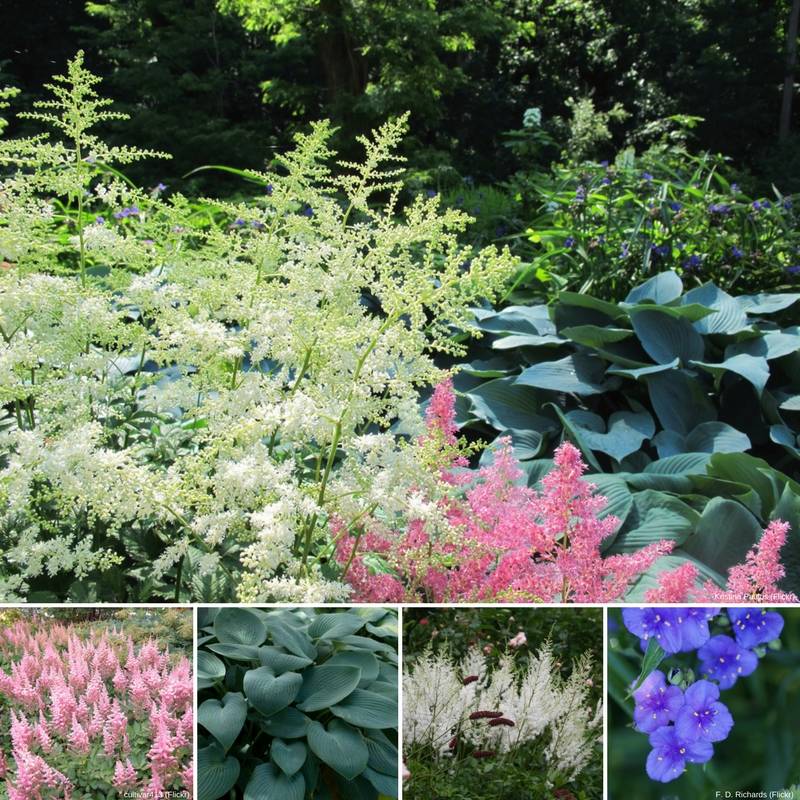
An example of an atmosphere for a woodland: Astilbe chinensis ‘Vision in Pink’ / Hosta tardiana ‘Halcyon’ / Astilbe arendsii ‘Diamant’ / Tradescantia andersoniana.
Among its favourites are also large carex or grasses, and bamboos.
In a brightly coloured bank setting, Astilbe ‘Red Sentinel’ will stand out against the yellow-green foliage of a ‘Aurea’ dogwood and will be a charming partner to euphorbias and ligularias.
In a wild garden at the edge or middle of a border, the upright pink panicles (Astilbe ‘Bumalda’ or white (Astilbe japonica ‘Deutschland’) will happily marry with the mauve, lilac, lavender, violet, and other cool shades of willowherbs and contrast with the orange of a crocosmia, and the yellow of daylilies.
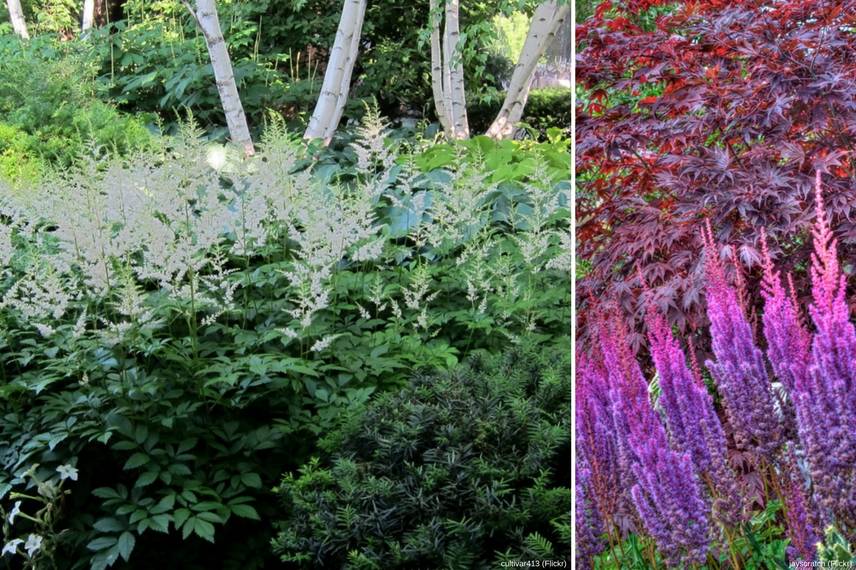
Last association idea: white astilbes like ‘Snowdrift’ or ‘Avalanche’ pair beautifully with the white bark of birches like Betula utilis ‘Jacquemontii’ / the Astilbe chinensis ‘Pumila’ harmonises beautifully with the purple foliage of Acer palmatum ‘Atropurpureum’.
To keep its roots fresh, consider groundcovers like sweet woodruff, heucheras, or a carpet of bugle.
→ Discover more association ideas with Astilbes in our advice sheet!
Useful resources
- Discover our stunning collection of Astilbes, featuring over 30 varieties
- Our advice sheet: Choosing an Astilbe
- Discover more comfort plants in our advice sheet
- Subscribe!
- Contents































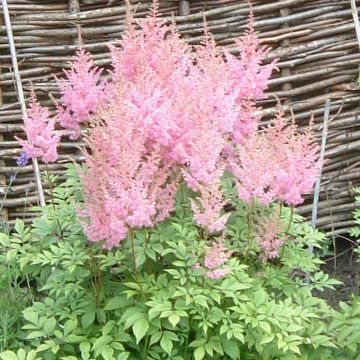
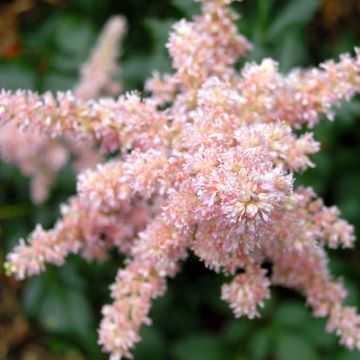
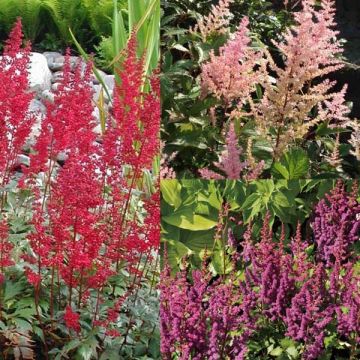

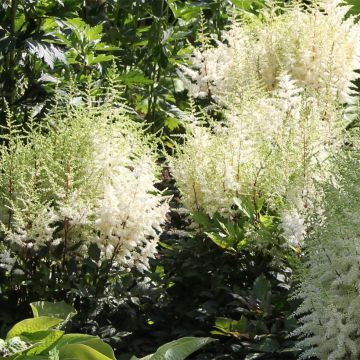
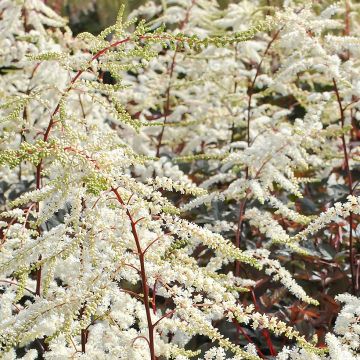
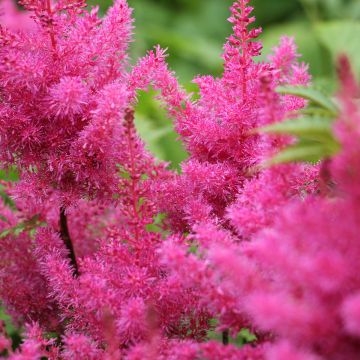

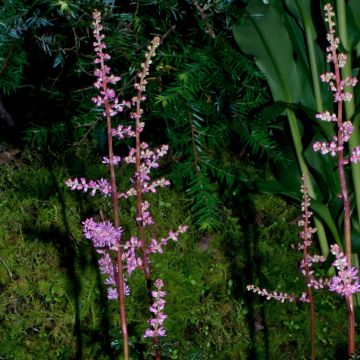
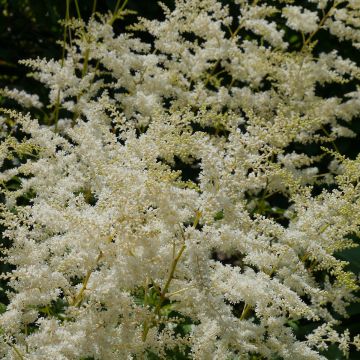
Comments